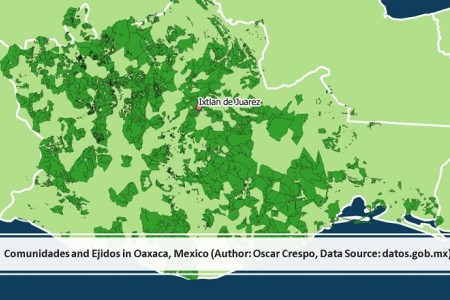The Economic Benefits of Mexico’s Community-Forest Management
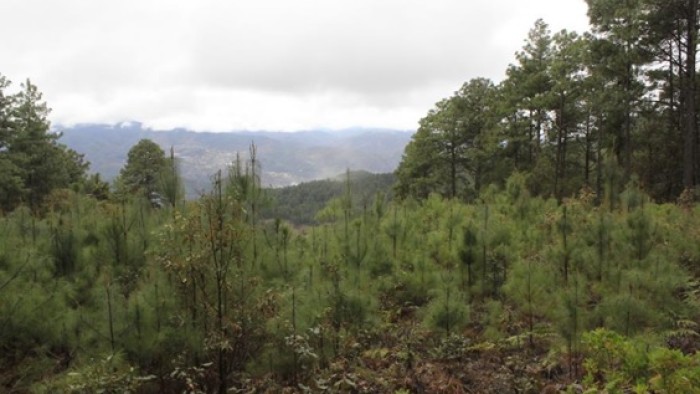
Oscar Crespo and Nick Biemiller
The community of Ixtlán de Juárez in Oaxaca, Mexico is a great example of the multiple economic, ecological and social benefits of a sustainably managed community forest. Forest management and ownership has fostered social and economic prosperity in this community while protecting the unique environmental values of its land. It is an indigenous Zapotec community located in one of the poorest areas of Mexico in the rugged mountains of the Sierra Juarez.
Revenues from forest management have been reinvested over the years in the creation and growth of different community-owned enterprises. This approach has significantly diversified the local economy, created multiple employment opportunities, and helped to reverse the migration patterns in this community.
Interest in community forests is expanding in the United States
In the United States, there is a growing interest in the community-forest model. It is a means of increasing the social, ecological and economic benefits of managed forests to local communities.
As described in the Community Forest Collaborative’s report “A Community Investment Strategy: Community Forests,” a community forest is defined as one where:
- Members of the community are actively involved in forest-management decisions.
- The community earns direct monetary and nonmonetary benefits from the forest.
- The ownership of the forest can be direct through the municipality or through a community-based organization. The organization holds the forest on behalf of the municipality.
- The conservation values of the forest must be permanently protected. This is sometimes done through a conservation easement.
There are some very good examples of community forests across the United States that exemplify the benefits of shared governance and collective ownership. These increase forests’ value to forest-dependent communities, especially in New England.
The economic impact is clearly positive for many of these community enterprises, as described in the Donella Meadows Institute’s study titled “Economic Impacts of the 13 Mile Woods Community Forest in Errol, New Hampshire.”
However, on an acreage basis, community forests are only a minor part of United States forests.
Community forests are succeeding in Mexico
In contrast, community forests are very common in Mexico. As outlined in the Rainforest Alliance’s 2013 report titled “Mexican Community Forestry: Enterprises and Associations as a Response to Barriers,” nearly 60 percent of the Mexico’s forests are owned by comunidades or ejidos. Comunidades belong to indigenous communities. Ejidos are properties that were granted to landless low-income citizens after the Mexican Revolution.
This percentage tends to remain stable over time because these lands can’t legally be sold in most cases.
A community forest is flourishing in Ixtlán de Juárez
Ixtlán de Juárez owns and manages a forest of 48,000 acres, its management plan says.
This community is internationally known for the success of its economic model and exemplary sustainable-forest-management practices. It was featured in the New York Times 2010 article titled “Growing a Forest and Harvesting Jobs.”
The article said the jobs and wealth created by the community-owned enterprises have reversed migration patterns and increased economic prosperity and employment opportunities in the second-poorest state of Mexico.
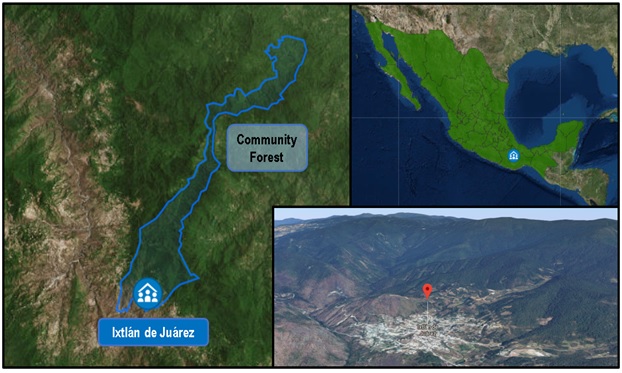
In 2017, the community was integrated by 521 comuneros. They are both community members and right holders. They manage the community and its enterprises.
Oaxaca is one of the most diverse states of Mexico, as the diagram below shows.

The forest’s role has changed over time
The recent history of forest management in the community started in the 1940s when its forests were under concession to a private company. Traditionally, Ixtlán de Juarez was not a forest-based economy but an agriculturally-based one, said Amado Mendez Pacheco, former municipal president of Ixtlán de Juárez.
The community began to concentrate on forestry in the 1940s after the collapse of the agricultural system, Mendez Pacheco said. Originally, the forests were under concession with Fabricas de Papel Tuxtepec (FAPATUX), a pulp and paper company, for a period of 25 years. Mendez Pacheco said FAPATUX selectively logged, or “high-graded,” the forests all over Sierra Juarez for the production of pulp.
When the company tried to renew the concessions, it was faced with severe opposition from local communities. “We gained road infrastructure, but didn’t get the value we should have,” Mendez Pacheco said. In 1992, technical services were finally transferred to the community. The first management plan was established in 1993.
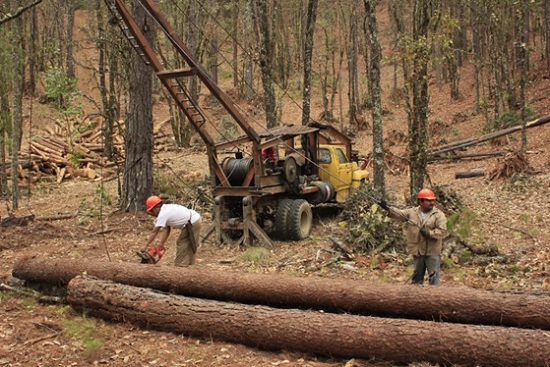
community-forest enterprise in Ixtlán de Juárez.
(Credit: Oscar Crespo)
Forest management has become community-friendly conservation
The rugged terrain has an elevation ranging from 500 to nearly 10,000 feet. Only one fourth of the forest area is intensively managed for timber production. More than half the area is managed for conservation or landscape restoration, according to Elias Santiago Garcia, a forest manager who works for the community.
About two thirds of the forests are temperate forests. The other third is classified as dry jungles or cloud forests. According to its management plan, Ixtlán de Juárez harvests a roundwood volume of approximately 30,000 cubic meters (6,237 thousand board feet (MBF)) per year.
Mendez Pacheco said the main goal is to manage the forest with the least negative impact and the most positive impact.
The community has been Forest Stewardship Council (FSC)-certified since 2001, according to the FSC. It was one of the first communities in Mexico to seek certification.
The community governs the forest through a network of enterprises
Mendez Pacheco said the comuneros, through the Asamblea de Comuneros, have the ultimate power over the management of their land. This includes community-owned forestry and other enterprises.
On a daily basis, different forest management activities are enacted by different community-forest enterprises (CFEs). The CFEs essentially function as small private companies with CEOs, but the ownership class consists of the comuneros rather than shareholders, Mendez Pacheco said.
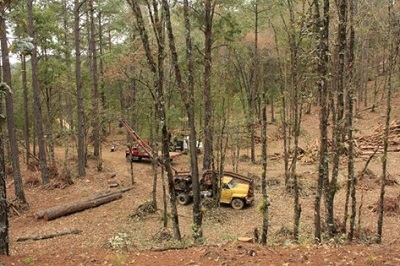
mountains near Ixtlán de Juárez. (Credit: Oscar Crespo)
The community forestry yields economic benefits
According to Mendez Pacheco, the revenues coming out of forest management are partially reinvested into the community and used to create other community-owned enterprises. Nowadays, the community owns several CFEs that cover the full value chain for wood products. This includes the forest itself, logging operations, sawmill use, furniture manufacturing, and direct sales. It has also collaboratively developed a furniture showroom called TIP Muebles with two other communities in Oaxaca (Pueblos Mancomunados and Santiago Textitlán).
To diversify employment opportunities, other community-owned enterprises have been created. These include an ecotourism agency, a water-bottling plant, a fish farm, a gas station, and other businesses, Mendez Pacheco said.
Enterprises such as the ecotourism project allow the community to communicate what it is doing to the world, which is a major benefit, Mendez Pacheco said. It has even created its own credit union that provides capital at low interest rates to comuneros to encourage them to engage in their own private ventures.
The profits from the community-owned enterprises are reinvested into other enterprises and the community, used for forest conservation and restoration, and redistributed among the comuneros. Their forest management and other community-owned enterprises have created wealth and plenty of employment opportunities.
Ixtlán de Juárez is regarded as a model for community forest management. Its goal is to create a space for others to learn and replicate the model, Pacheco said. Representatives from other comunidades and ejidos around the country come to Ixtlán de Juárez to try to reproduce their model.
There are economic, demographic and sociopolitical barriers to the application of such vertically-integrated, community-owned-and-managed enterprises in the United States.
In the United States, community ownership represents a minimal part of the forest area. There are significant differences in the social structures and traditions that enable the success of these community-owned companies.
There are certainly valuable lessons to be learned from the Mexican community-forest model and the impressive achievements of Ixtlán de Juárez.

To comment on this article, please post in our LinkedIn group, contact us on Twitter, or use our contact form.
